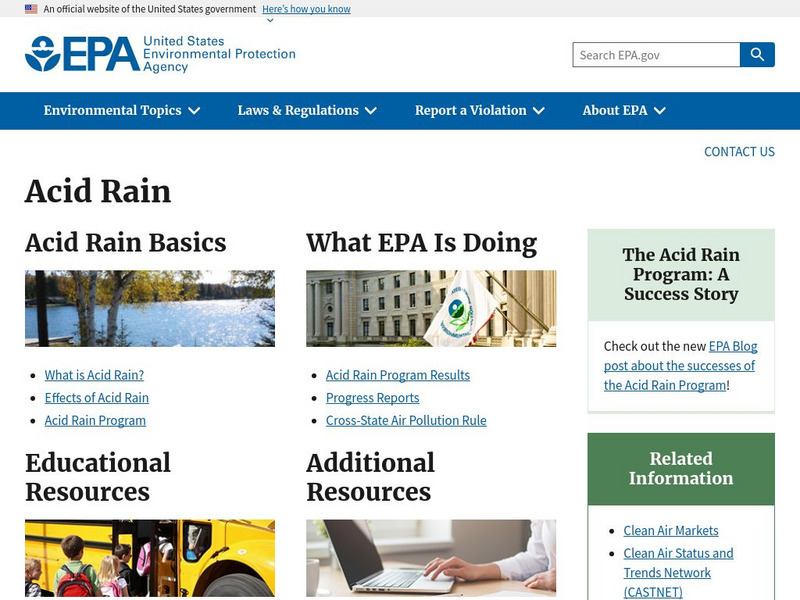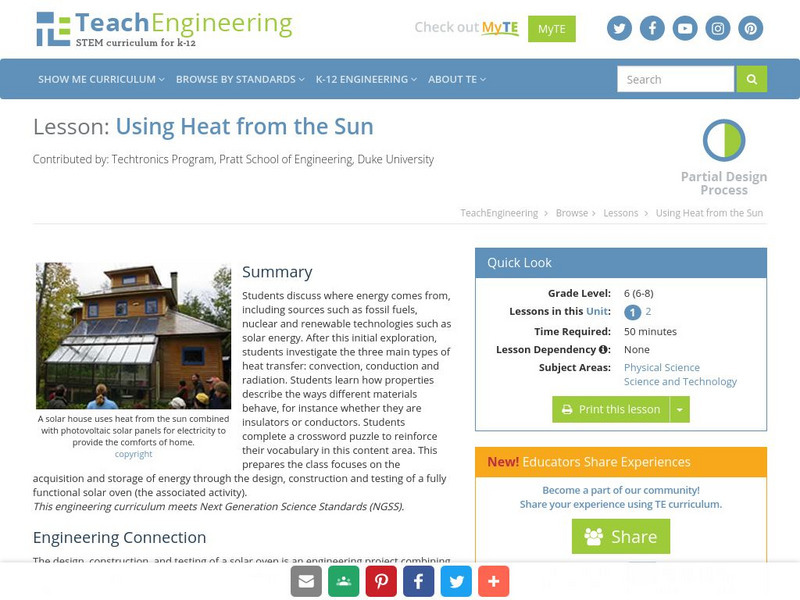American Geosciences Institute
American Geosciences Institute: Energy
Seven hands-on lessons module where students learn about energy. These inquiry-based explorations investigate where energy resources come from and how they are converted into electricity, how fossil fuels form, the importance of...
US Energy Information Administration
Eia: Iraq Energy Chronology
The Energy Information Administration provides a detailed chronology of events in Iraq related to energy. Chart begins with 9/17/80 when Iraq broke its treaty with Iran and continues to the present. Site seems to be updated periodically.
BioEd Online
Bio Ed Online: Global Atmospheric Change
A teaching guide with eleven lessons on the atmosphere, and the impact that different kinds of energy have on the atmosphere and ecological systems. The unit and accompanying PowerPoint can both be downloaded.
BioEd Online
Bio Ed Online: Finding the Carbon in Sugar
Students learn that fossil fuels release energy when they are burned, and this takes the forms of light, heat, gases, etc. In this instructional activity they explore combustion with a candle and with sugar. The instructional activity...
BioEd Online
Bio Ed Online: Fossil Fuels and the Carbon Cycle
In the following lesson students learn how geologists locate fossil fuels by using a straw to extract "core samples" from a model that has different layers. Student sheets are provided in English and in Spanish.
American Institute of Biological Sciences
Action Bioscience: Rethinking Fossil Fuels
Find out how fossil fuels impact the environment and cause climate change.
Encyclopedia of Earth
Encyclopedia of Earth: Greenhouse Gas
Explains what greenhouse gas is, how the greenhouse effect works, and the history of fossil fuel combustion. Causes of other damaging greenhouse gases, including methane, nitrous oxide, chlorofluoracarbons, hydrofluorocarbons, and...
Nature Conservancy
The Nature Conservancy: Renewable Energy
In this lesson, students explore solar and wind power-two important renewable energy sources.
DOGO Media
Dogo News: Peek Inside the World's First Carbon Neutral City
A new kind of city is being built in the Arab desert. Read about the unique engineering that is creating Masdar, a "city of the future" which doesn't use fossil fuels.
Georgia Department of Education
Ga Virtual Learning: Ap Environmental Science: Energy Use and Energy Sources
This interactive learning module will focus on the fundamentals of energy and energy sources, renewable and nonrenewable, that support the human population. Students will also explore our dependence on nonrenewable fossil fuels to...
US Environmental Protection Agency
Epa: Acid Rain: Students Site
Use this student portal to understand all you can about acid rain and its harmful effects. Modules for interactive games, stories, puzzles, vocabulary terms and links to other activities and experiments.
TeachEngineering
Teach Engineering: Energy in Our Lives Carousel
This activity is a way for students to discover that they already know a lot about energy through their own life experiences. As active consumers of various forms of energy, they are aware of energy purchases for electricity, home...
CPALMS
Florida State University Cpalms: Florida Students: Sustainability
Understand the definition of sustainability with this tutorial. Also, explore possible solutions to obtain sustanability in an environment.
Other
International Institute for Sustainable Development: Energy
Learn what the International Institute for Sustainable Development is doing in Canada to help ensure that clean, alternative energy sources are used in the future.
The Environmental Literacy Council
Environmental Literacy Council: Petroleum
Petroleum and petroleum-based products have played an impressive role as energy for the 20th century. Learn about its uses, benefits, increased consumption, effects on our environment, and the many new replacement technologies.
TeachEngineering
Teach Engineering: Dinosaur Breath
Through discussion and hands-on experimentation, students learn about the geological (ancient) carbon cycle. They investigate the role of dinosaurs in the carbon cycle and the eventual storage of carbon in the form of chalk. Students...
TeachEngineering
Teach Engineering: Rolling Blackouts & Environmental Impact
The goal is for the students to understand the environmental design considerations required when generating electricity. The electric power that we use every day at home and work is generated by a variety of power plants. Power plants...
TeachEngineering
Teach Engineering: Using Heat From the Sun
In this lesson plan, students will first discuss where energy comes from, including sources such as fossil fuels, nuclear, and such renewable technologies as solar. After this initial exploration, students will investigate the three main...
Annenberg Foundation
Annenberg Learner: The Habitable Planet: Energy Challenges
With this resource, users join investigators in the exploration of humans' use of and dependence on the many energy resources. Learn about new technologies such as carbon capture and sequestration as an alternative to reduce our carbon...
US Energy Information Administration
U.s. Eia Energy Kids: Nonrenewable Oil (Petroleum)
Provides good information about oil made from petroleum. Covers production, offshore drilling, fuel products made from crude oil, the refining process, and environmental issues. Includes helpful charts and maps.
PBS
Pbs Learning Media: Global Warming: Graphs Tell the Story
Examine these graphs from the NOVA/ FRONTLINE Web site to see dramatic increases in the temperature of Earth's surface and greenhouse gases in the atmosphere.
University of Oregon
Museum of Natural and Cultural History: Rocks and Minerals: Everyday Uses
Click on the shelves in this virtual exhibition to learn about the many rocks and minerals that we use in our everyday lives.
Other
Wbur: New England's Electric Power Grid Is Undergoing a Transformation
This article discusses New England's developing hybrid power grid, a network that relies on a variety of energy resources, including fuels and alternative energy sources and technologies. The ongoing transformation to renewable energy is...
US Department of Energy
U.s. Department of Energy: Coal: Our Most Abundant Fuel
The U.S. has enough coal to last for the next 200-300 years. So why are we not using more of it? This article describes the different types or "ranks" of coal, the history, and the problems with burning coal for energy.





















